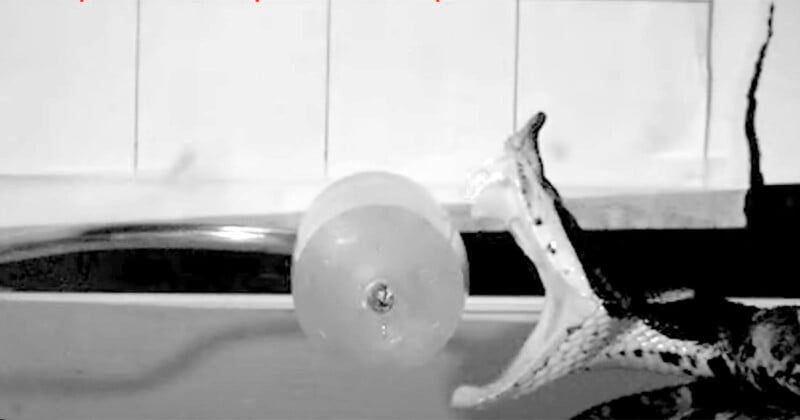Snake Bites Captured at 1,000 Frames Per Second on High-Speed Camera

Scientists used two high-speed cameras recording at 1,000 frames per second to capture the lightning fast action of a venomous snake bite. The snakes can react in less than 100 milliseconds.
A new study published in the Journal of Experimental Biology examined how 36 species from three families — vipers, elapids, and colubrids — deliver their bites. With the footage slowed down, scientists can better study the strikes.
In an article for Science Alert, co-author of the study Professor Alistair Evans explains that scientists began using high-speed photography to study snake bites in the 1950s. Since then, technology has vastly improved and this latest study is one of the most high-resolution, data-rich studies of snake bites ever conducted.
The snakes were observed striking a cylinder of heated ballistic or medical gel designed to mimic the structure and temperature of mammalian tissue. Researchers reconstructed the strikes in three dimensions to measure how quickly the snakes moved, how their jaws opened, and how their fangs engaged.
Vipers were found to strike fastest. Species such as the sharp-nosed pit viper and western diamondback rattlesnake launched their attacks explosively from a coiled position, reaching prey in less than 100 milliseconds. In 84 percent of recorded viper strikes, the target was reached in under 90 milliseconds, faster than the average reaction time of mammals the snakes typically hunt. Vipers possess long, hinged fangs that unfold during the strike.
“When the snake is about to hit their prey the vipers are actually able to fold out their fangs,” explains Professor Evans, a zoologist at Monash University. After initial contact, many vipers adjusted their bite, “walking” their fangs forward one at a time to achieve better placement before injecting venom.
Some vipers also showed that fang breakage can occur during a strike. In one instance, the fang of a blunt-nosed viper snapped off and flew through the air.
“Fangs have previously been found in snake scats, which means fangs often break off during prey penetration, remain stuck in the prey and are swallowed by the snake,” the researchers explain in their paper. Professor Evans explains that fang loss does not harm the snake because, “They’re replaced — the snakes make new fangs throughout their life.”
Elapids, including species such as the Cape coral snake and rough-scaled death adder, approached more slowly. These snakes have permanently erect but shorter fangs. They tended to bite repeatedly rather than strike once.
Colubrids, which have fangs situated toward the back of the mouth, employed yet another strategy. After biting down, they moved their jaws from side to side to deepen the wound and facilitate venom delivery. “Once they’re biting down they saw or rotate their jaws and cut into the prey, which presumably then gives better penetration of the venom,” says Professor Evans.
Different strike strategies reflect fang anatomy and ecological adaptations. “The differences in behaviour that have been reported for viperids, elapids, and colubrids correlate well with what we know about their fang anatomy,” Alessandro Palci of Flinders University tells the Guardian.
Despite the deadly efficiency of venomous snakes, their behavior is often defensive. If left alone, they are not dangerous.
Earlier this week, PetaPixel reported on a man who built a two billion FPS camera to record the path of light.